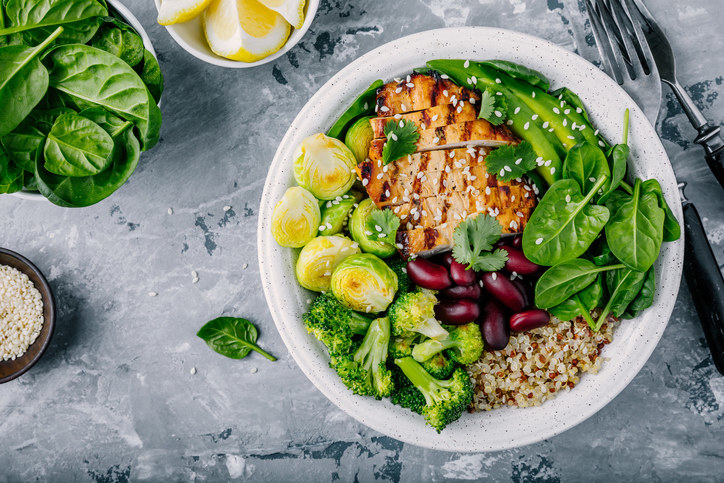Two-thirds of Australians are overweight or obese and public health strategies have so far failed to address this healthcare crisis – probably because our choices around food are much more complicated than you might initially think.
Decisions about what we eat are directed by a complicated blend of socioeconomic, education, and cultural factors.
So what do we really know about diet? And why have we so far failed to redirect Australian food choices?

The CSIRO has released a report this week outlining a new national healthcare strategy, aiming to shift the focus from illness treatment to prevention over the next 15 years.
The Future of Health report provides a list of recommendations with the goal of addressing health inequity, establishing preventative (rather than reactive) strategies, and using precision medicine techniques such as testing individual gut biota.
In general, Australia has encouraging health rankings compared with other countries in the Organisation for Economic Co-operation and Development (OECD).
Australia has the fourth lowest rate of disability-adjusted life years among OECD countries (disability-adjusted life years are the number of years lost from a "healthy life" due to illness). It also has one of the lowest rates of smoking among people aged 15 years or older.
Despite this, Australia is still pulling some grim health statistics, with an average of 11 years spent in ill health across a lifetime, which is the highest among all the OECD countries.
Australia, like most middle or high income nations, suffers profoundly from adverse health effects related to obesity and being overweight.
More than three in five adult Australians and one quarter of Australian children are considered overweight or obese.
If you needed any reminding, excess weight has been shown to increase the likelihood of a number of serious problems including heart disease, type 2 diabetes, multiple forms of cancer, bone disease and sleeping issues.
According to the latest Australian Health Survey, problems related to obesity and excess weight are responsible for 11% of the total health burden in Australia.
These issues are most pronounced amongst lower socioeconomic groups and Indigenous Australians. The lowest socioeconomic strata in Australia experiences a rate of burden related to obesity and being overweight 2.3 times that of our highest socioeconomic group.
Doctor Rob Grenfell, director of health and biosecurity at the CSIRO, told BuzzFeed News that there is still "startling inequity" in Australian healthcare and that disparity in nutritional outcomes are one of the primary examples of this problem.
"About 60% of Australians have poor health literacy, they don't know what to do and they just don't understand.
"That's not trying to be patronising, it's just saying that the information we've given them hasn't been relevant or at least been consumable in a way that they understand."
Grenfell points out that personal food choices are the result of a specific mixture of social and individual factors such as mental health status, education level, and family and cultural background.
He believes that nutrition in public health has so far failed to effectively address these complexities.

Is this just a matter of people in lower socioeconomic brackets eating cheap junk food?
Well, no. The picture is a little more complicated than that.
Professor Amanda Lee, a research fellow from the School of Public Health at the University of Queensland, says that one factor of socioeconomic disparity in the obesity crisis is about where people live.
"There's area-level disadvantage — if you live in an area that's not a high income area, you have different access to services, resources and shops."
Lee also found a surprising result in a 2017 study that strongly suggested income alone does not enter heavily into dietary choices.
When her team compared the cost of different diets, they found that adhering to the Australian Dietary Guidelines actually costs 15% less than diets where people are eating more takeaway and discretionary (junk) foods.
"If you buy healthy foods, you need to know how to cook those, you need to have more time, you need to have cooking facilities," Lee said. "If you don't have that then those takeaway items can be very appealing and people ... who are time-poor ... might [choose] convenience to produce a meal for the family."
Lee says that when research controls for factors such as income, smoking and physical activity, the factor that is most closely associated with how people eat is education level.
She theorises that this may come down to how we interpret messages in food advertising.
"People with higher opportunities for education may have more resources to be able to see through that false advertising, or the promotion of unhealthy foods. They may have more resources to be able to see through that false advertising or the promotion of the unhealthy foods."
The cultures we come from also affect how seriously we take dieting messages.
Tamara Melton, a registered dietician from Atlanta and co-founder of Diversify Dietetics, believes that the Eurocentric focus of public dieting campaigns can turn a lot of people off the idea of eating healthily.
"If you go out there, even the healthiest 'exotic' food is still the Mediterranean diet at the end of the day — that's as far as we've gotten. But there's all these other cultures of food and we haven't really studied them to look at the components of the food and also people's lifestyle."
Melton believes that the images associated with dieting too often exclude food from minority cultures.

"For many people who have emigrated away from their homelands, it's the only thing they remember, it's all they have left of their homelands and you can't ask them to let that go.
"By not including other examples [of food culture], I feel to our patients and clients, it just says that they should be omitting the way they eat and we're saying the way they eat is wrong."
Melton believes that Eurocentric healthy food imagery, such as the stereotypical single breast of chicken, broccoli and brown rice, implies that people should give up foods that are intrinsically linked to their culture, and that this is turning people away from the message.
Grenfell says "the Mediterranean diet is healthy, but so are many other rudimentary diets around the world — and the unfortunate thing is that the Westernisation of our food intake is one of the principle reasons for global obesity".
Melton recalls a friend complaining to her that they had let their diet slip because they ate Thai food.
"I was like, 'Let's break down what it is: it's seafood, a broth, tonnes of vegetables and honestly a little bit of carbohydrate with the rice if you have it. It is probably one of the healthiest meals that you can have'.
"The reason you haven't thought about it is because you just haven't seen it presented in the way that I just described to you."

Melton believes modern dieting messages make healthy eating seem inaccessible to large swathes of the population. In particular, the "clean-eating" trend propelled by social media, where photos of chia pods and brown rice bowls dominate depictions of nutritious eating.
"All these forms of food are a really elitist way of eating honestly because, really, the people who can afford it are upper middle class and above."
Melton says that so-called clean-eating has turned into a female-focused and "morally superior" way of eating and is driven by marketing fads. It has led to her seeing clients who express concern about healthy eating because they can't afford high-end health foods and organic produce.
"Organic foods do not necessarily have more nutrition than other foods and [inorganic food] is safe, it wouldn't be out on the market if it wasn't safe.
"Frozen foods are safe for you and they actually have more nutrients a lot of the time because they were frozen at their peak of freshness, and they can stay in your freezer for a month."
Lee says "the most important thing is that people eat a varied diet of basic healthy foods. There's very little evidence that specialty foods such as organic foods are any better for our health. They come at a premium and they may provide some benefit to the environment, but there's no evidence at all that they're better for our health.
"Sometimes organic foods are even transported a greater distance to get to market so they can be even less nutritional [than regular produce]."
Lee points out that reducing diets to extremely simple components can help people across all socioeconomic brackets and cultures adjust to healthy eating.
"We don't need special products like Acai berries or the latest dietary fad, we just need to eat a big variety of healthy foods, with vegetables of different colours, sizes and shapes, lean meat, poultry, eggs, fish, milk, cheese."
